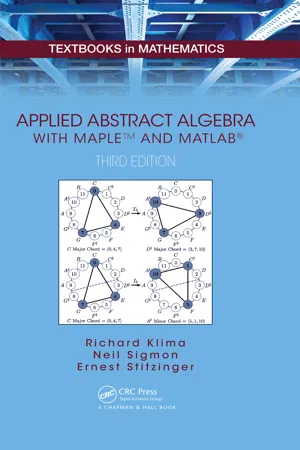
eBook - ePub
Applied Abstract Algebra with MapleTM and MATLAB®
This is a test
- 555 pages
- English
- ePUB (mobile friendly)
- Available on iOS & Android
eBook - ePub
Applied Abstract Algebra with MapleTM and MATLAB®
Book details
Book preview
Table of contents
Citations
About This Book
Applied Abstract Algebra with MapleTM and MATLAB provides an in-depth introduction to real-world abstract algebraic problems. This popular textbook covers a variety of topics including block designs, coding theory, cryptography, and counting techniques, including Polya's and Burnside's theorems. The book also includes a concise review of all prereq
Frequently asked questions
At the moment all of our mobile-responsive ePub books are available to download via the app. Most of our PDFs are also available to download and we're working on making the final remaining ones downloadable now. Learn more here.
Both plans give you full access to the library and all of Perlego’s features. The only differences are the price and subscription period: With the annual plan you’ll save around 30% compared to 12 months on the monthly plan.
We are an online textbook subscription service, where you can get access to an entire online library for less than the price of a single book per month. With over 1 million books across 1000+ topics, we’ve got you covered! Learn more here.
Look out for the read-aloud symbol on your next book to see if you can listen to it. The read-aloud tool reads text aloud for you, highlighting the text as it is being read. You can pause it, speed it up and slow it down. Learn more here.
Yes, you can access Applied Abstract Algebra with MapleTM and MATLAB® by Richard Klima, Neil Sigmon, Ernest Stitzinger in PDF and/or ePUB format, as well as other popular books in Mathematics & Mathematics General. We have over one million books available in our catalogue for you to explore.
Information
Chapter 1
Preliminary Mathematics
There are two purposes to this chapter. We very quickly and concisely review some of the basic algebraic concepts that are probably familiar to many readers, and also introduce some topics for specific use in later chapters. We will generally not pursue topics any further than necessary to obtain the material needed for the applications that follow. Topics reviewed in this chapter include permutation groups, the ring of integers, polynomial rings, finite fields, and examples that incorporate these topics using the philosophies of concepts covered in later chapters.
1.1Permutation Groups
Suppose a set G is closed under an operation *. That is, suppose a * b ∈ G for all a, b ∈ G. Then * is called a binary operation on G. We will use the notation (G, *) to represent the set G with this operation. Suppose (G, *) also satisfies the following three properties.
- (a * b) * c = a * (b * c) for all a, b, c ∈ G.
- There exists an identity element e ∈ G for which e * a = a * e = a for all a ∈ G. 3.
- For each a ∈ G, there exists an inverse element b ∈ G for which a * b = b * a = e. The inverse of a is usually denoted by a−1 if * is a general operation or multiplication, and −a if * is addition.
Then (G, *) is called a group. For example, it can easily be verified that for the set ℤ of integers, (ℤ, +) is a group with identity element 0, but (ℤ, ·) with normal integer multiplication is not a group.
Let S be a set, and let B(S) be the collection of all bijections (i.e., one-to-one and onto mappings) on S. Then any α ∈ B(S) can be uniquely expressed by its action α(s) on the elements s ∈ S.
Example 1.1 If A = {1, 2, 3}, then B(A) contains six elements. One α ∈ B(A) can be expressed as α(1) = 2, α(2) = 3, and α(3) = 1. □
Let ∘ represent the composition operation on B(S). Specifically, if α, β ∈ B(S), then define α ∘ β by the action (α ∘ β)(s) = α(β(s)) for s ∈ S. Since the composition of two bijections on S is also a bijection on S, then α ∘ β ∈ B(S). Thus, ∘ is a binary operation on B(S). It can easily be verified that (B(S), ∘) is a group.
A group (G, *) is said to be abelian or commutative if a * b = b * a for all a, b ∈ G. For example, since m + n = n + m for all m, n ∈ ℤ, then the group (ℤ, +) is abelian. However, for a set S with more than two elements, there do exist α, β ∈ B(S) such that α ∘ β ≠ β ∘ α. Thus, for a set S with more than two elements, the group (B(S), ∘) is not abelian....
Table of contents
- Cover
- Half Title
- Series Page
- Title Page
- Copyright Page
- Table of Contents
- Preface
- 1 Preliminary Mathematics
- 2 Block Designs
- 3 Error-Correcting Codes
- 4 BCH Codes
- 5 Reed-Solomon Codes
- 6 Algebraic Cryptography
- 7 Vigenère Ciphers
- 8 RSA Ciphers
- 9 Elliptic Curve Cryptography
- 10 The Advanced Encryption Standard
- 11 Pólya Theory
- 12 Graph Theory
- 13 Symmetry in Western Music
- Bibliography
- Hints or Answers for Selected Exercises
- Index